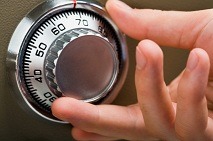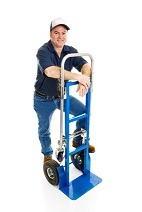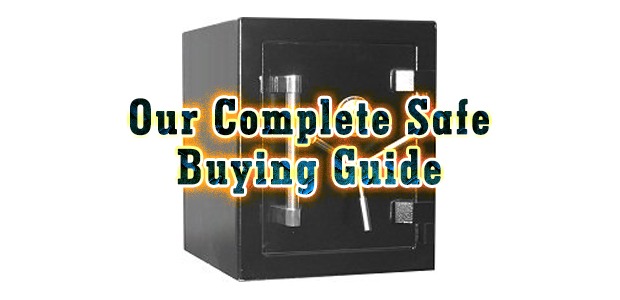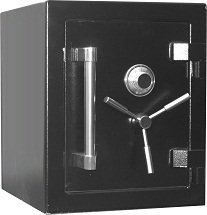Welcome to the Complete Safe Buying Guide.
We have put together this complete safe buying guide to help assist you in your purchase of a safe. There are many options to consider and this should help get you started.

Safe Buying Guide – A Story
Here is a story dealing with one of these fire safes.
A call is received from a residential location. The customer had misplaced the combination to his safe. He wanted to retrieve the contents of the safe without damaging it if possible. He had a small Sentry fire safe – a basic fire safe with 1 hour of fire protection and a basic combination lock. This Sentry fire safe was great for fire protection, but offered little or no security.
He didn’t know any numbers to the combination. A technique called manipulation which is similar to what you would see on TV when people dial the safe open with a stethoscope can be used. After about 5 minutes, the final number of the combination can be found and decoded without damaging the safe.

Although this is an extreme situation, it is very common that items of value are placed within safes that are not made to secure items of such value. For this reason, this safe buying guide is for those interested in buying a safe.
Safe Buying Guide – Safe Type
Safes come in many different types and each safe can have a different function. Below we will go over some of the more popular safe types and what they are best suited for.
Fire Safes
Fire safes are used to protect contents from a standard fire for a stated period and temperature. A standard fire safe will protect paperwork and other items that burn or melt at a high temperature. There are items that will likely be damaged in a standard fire safe. Plastics and media such as DVDs, tapes and CD’s will melt and become useless if put through a fire in a standard fire safe. If you plan to store this type of item you will be better served with a data/media safe which we explain better later in the safe buying guide. Fire safes generally provide very little burglar protection and can be opened easily with hand tools. Fire safe generally provide 1 hour of fire protection, but there are also 2 hour models available. Fire safes are usually made from a thin metal shell filled with fireproofing material.
Steel Security Safes
Burglar and steel security safes are made of steel and usually offer no fire protection. Items placed inside including cash will burn in a fire and will not be recovered. The steel of these safes heat up in a fire and would act as an oven cooking everything inside. Safes of this type vary from unsecure to some that can withstand a common burglar attack. Professional thieves or a burglar with sophisticated equipment may be able to open a burglar or steel security safe given enough time with the safe. When items of a high monetary value must be secured, a High security TL-15 or TL-30 model should be used.
Fire & Burglar Safes
Fire & Burglar safes combine the benefits of a fire safe with the security of a burglar or steel security safe. In most cases, this is the best option for a standard home or business to keep some valuables and important paperwork safe. These safes are usually made with steel inner and outer shells filled with a composite fire & security material. Some of these safes utilize fireboard on the inside to provide the fire protection.
Data & Media Safe
Data & Media safe are used to protect Data and Media from fires. The melting temperature of most CDs, DVDs, tapes, film and other storage is as low as 125 degrees Fahrenheit. These safes are made to keep the inside of the safe below 125 degrees for a period of 1 or 2 hours. Data/Media safes can also be found in a 3 hours model but they are not common.
Drop Safes & Deposit Safes
Drop or depository safes are made to secure cash received during the day by businesses. Most drop or depository safes are not made to protect cash overnight. These safe have a slot, drop door or rotary hopper to place cash into which is then “dropped” into a secure area inside the safe. Drop or deposit safes are generally not fireproof, although at least one fireproof model has been produced in the past.
Gun Safes
Gun safes are used for many different purposes. The most common is to protect firearms and ammo from kids, burglars and fire. Gun safes can be fire resistant, but may not be. Most gun safes that don’t offer fire protection are referred to as gun cabinets. Gun safes also are commonly converted to all shelves on the inside and used in homes and businesses for a variety purposes. Gun safe come in many different security levels, fire protection and sizes.
Floor Safes
Floor Safes are made specifically to be placed below floor level usually encased in concrete. Floor safe may offer some fireproofing being underground, but they are not made to be fireproof. The fireproofing the safe offers is only due to the fact that the safe is encased in concrete and the heat will have a difficult time getting to the contents of the safe. Floor safes are generally very secure and difficult to break into when properly installed. Floor safes also are easily concealed under carpet and other flooring materials. These safes are great to plan into a newly built home.
Wall Safes
Wall Safes can be fireproof, but most are not. These safes are placed into a cutout in the wall and usually secured to the studs. Wall safes have the advantage that they are easily hidden behind a picture and can be very difficult for a burglar to locate. A wall safe that does not have a fire label will not offer any fire protection and all burnable contents will be lost in a fire. Fireproof wall safes typically required a very deep wall for installation. A wall with 10 or more inches of depth will likely be needed for fireproof wall safes.
High Security Safes
A high security safe is used to protect items of great value. These safes are commonly used in banks, jewelry stores, pawn shops and other location that need to keep valuables safe. Some high security safes are solid steel and do not offer fire protection. Some are high security fire safes and offer great fire protection and great security. If you plan to protect your valuables with the most security available a high security safe should be your first choice.
Safe Buying Guide – Safe Locks
Safe locks come in many different forms and many different security levels. Safe locks can be grouped into 3 categories.
- Electronic Safe Locks
- Combination Safe Locks
- Key Safe Locks
All three of these safe locks can offer the security you need on your safe. All the safe locks have high end models and low end models. Find out more about safe locks at our safe lock page.
Safe Buying Guide – Size

Most moving companies, rigging companies, locksmiths and safe companies will be happy to move a safe of almost any weight into your home or business for a fee which varies by location. There can often be regret over not paying a small additional amount for the next larger model. Most people find many more items to place inside their safe after they begin to utilize the safe. A safe can be upgraded to the next size for a very small percentage of the safe price. Most models can be upgraded for between $20 and $100 additional depending on the safe you are looking at.
The below weights and manpower recommendations are just suggestions. Your situation and safe may require more manpower or even a professional. The manpower and equipment required can vary depending on several factors including movers physical ability, equipment used and obstacles that must be overcome to place the safe.
Safe Buying Guide – Moving Your Safe

A safe of 50-100 lbs can be moved easily with one person and a dolly or hand cart or 2 people by hand.
A safe of 100-200 lbs can be moved by 2 people and a dolly or hand cart.
A safe weighing 200-400 would require a heavy duty dolly with straps and 2-3 people to move the safe safely.
A safe with a weight of 400-600 lbs can be moved with 3-4 people and a heavy duty hand cart with straps, you must be careful when moving a safe with a weight of 400-600 lbs.
A safe weighing more than 600 lbs should be left to professionals to move especially if steps are involved. Some safe of these weights come with casters (one way wheels) that if no steps are involved in the move, can be rolled into place without professional help.
Safe Buying Guide – Securing Your Safe

1. Earthquake zones may have large cables running through the cement in the floor which should not be drilled into.
2. Some locations have heated tile or floors which should not be drilled into.
3. Some cement floors have rebar running through the cement that may cause problem and make it difficult to drill through.
4. Safes above 700 lbs. are generally very hard to move and may not need bolted down. These safes may not offer a pre-drilled bolt down hole due to the weight of the safe itself. If no pre-drilled bolt down hole is provided with the safe, it may not require the additional security of being bolted down.
For detailed instructions on bolting down a safe visit our safe installation page.
Safe Buying Guide – Summary
Believe it or not, there professional burglars who can steal (2) 2000 pound safes in the same night or worse! These are exceptional thieves that had the ability to defeat alarm systems, camera systems and all multiple locks.
When purchasing a safe you must decide what will work best for you. This safe buying guide hopefully provided you with some information to get started finding the proper safe for your situation. If you find the the safe buying guide does not contain something you think it should, please contact us and we will happily add to the content so it remains the most complete safe buying guide anywhere.


